Pia Padukone's Blog
February 24, 2015
Oscars 2015: Birds vs Boys
We’re b-a-a-c-k! After a super long hiatus (7 months, to be exact), we return to our regularly scheduled program. We’ve had excuses in the past, but this one is actually legit. In September, we welcomed a new member to our family: our daughter Salma. She has done everything she’s supposed to do in the first portion of her life: coo, pee, poop, amaze, astound and paralyze us into complete mush. Which explains our 7+ month hiatus. Forgive us.
But there’s no better time for a return than one of Pia’s favorite nights of the year: the 87th Annual Academy Awards. When the nominees were first announced, we had a moment’s hesitation: could we pull it off? We had to. There was no doubt. Introducing this year’s nominees:
Whiplash: Most people hadn’t even heard of this movie; it’s the underdog of the year. A young man at a Julliard-like conservatory is brutally schooled by a teacher from hell. It’s tough love, as the teacher (JK Simmons) tries to sculpt his students into the next Miles Davis or Charlie Parker. The student (Miles Teller) licks his wounds by watching movies with his father (Paul Reiser) and enjoys his sweet and savory snack of choice: popcorn with a bag or Raisinets dumped in (oh boy, what a metaphor!)

Boyhood: Director Richard Linklater followed the lives of a young boy and the actors who played his sister, mother and father over the course of 12 years in order to watch them all age in real time instead of changing actors or using aging makeup techniques. It resulted in what I thought was a brilliant form of storytelling; though the story itself wasn’t anything to write home about, it was one of the picks to win best picture. In the movie, the main character Mason and his girlfriend sit in a diner on the eve of their graduation ruminating about the future and eating melted ‘queso’ into which they dip tortilla chips. We served Assorted Aged Cheeses - gouda, gruyere, cheddar and manchego, all aged from 2 months to 2 years - as a nod to Mason’s journey from youth to adolescence and finally adulthood.
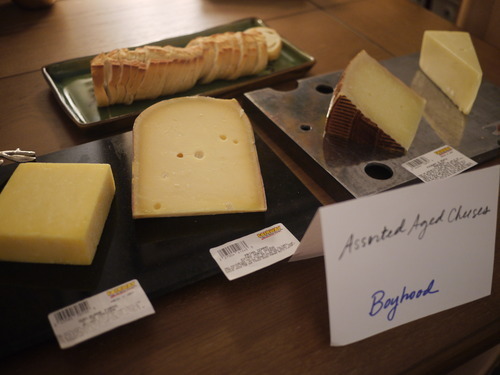
Selma: The story of Martin Luther King Jr’s leadership during one of the most pivotal peaceful protests in the history of American civil rights is also one of the most timely. Selma is about the black struggle to acquire voting rights in the state of Alabama with government, racist leadership and the infrastructure that was put in place that made it nearly impossible to achieve. We made a healthier nod to Southern food in order to encourage a healthy government with equal rights: Swiss Chard Fritters.
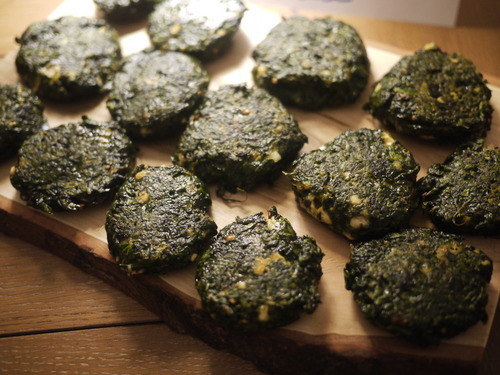
The Theory of Everything: Stephen Hawking, renowned for his work in physics, cosmology and all things black holes, could arguably not have written A Brief History of Time without the support of his loving wife, from whom he is now divorced. The screenplay for this movie was based on her book, and it tells of a love so strong that it surpassed all the odds, both physical and physic. My mom helped me with these dishes, providing a Brief History of Thyme with Roasted Vegetables with a Thyme-Carrot Top Pesto as well as the antithesis to a black hole: a brilliant salad with marinated artichokes, tomatoes and cucumbers.
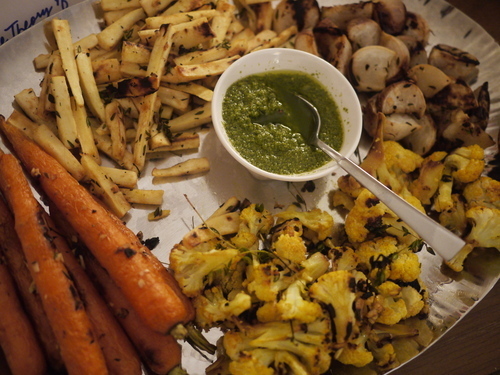
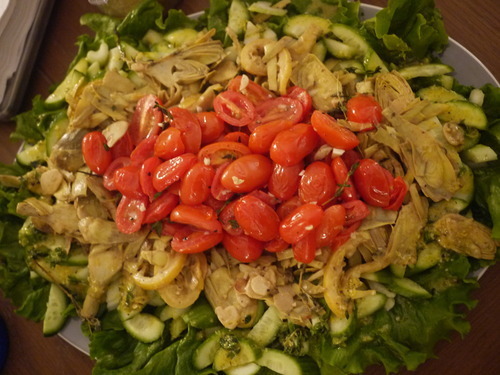
The Imitation Game: As far as I am concerned, this was one of the most tragic stories told this year. It tells the story of Alan Turing (Benedict Cumberbatch), the British mathematician and cryptologist who broke the German Enigma code and arguably won WWII. He was a brilliant but socially awkward mind. I won’t spoil the story if you haven’t seen it, but his story isn’t a happy one even though it’s said that he helped to shorten the war by 2 years and saving 14 million lives. In the movie, Turing makes his preference for soup over sandwiches clear. So we served spicy tomato soup with coded alphabets.
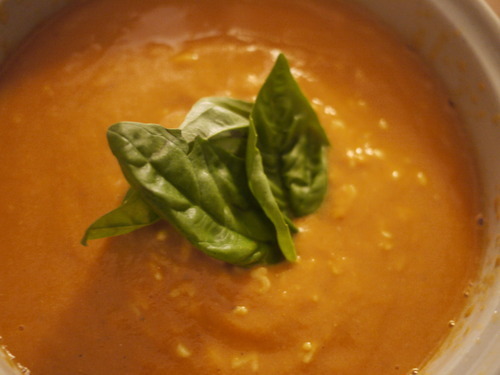
American Sniper: It seems that there’s an American war movie every year. While I won’t provide my political thoughts on these entries, I will say that they make the menu pool rather predictable. American Sniper is the story of a SEAL turned legend when he takes down the most Iraqis during his posts protecting Marines. We served Masgouf, an Iraqi style red snapper served with preserved lemon, tomato, chili in vinegar and onion. Note: masgouf is the way to prepare the fish: butterflied, over a fire pit so that the char rises and gives the fish its smoky flavor. We broiled ours, but it was utterly delectable.
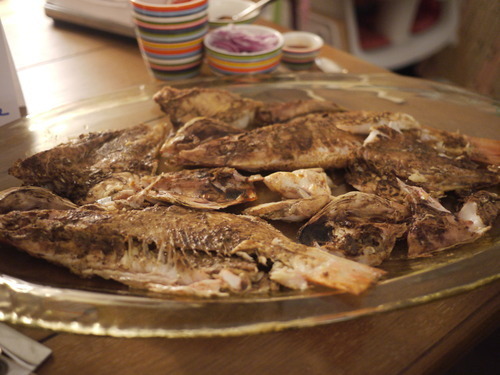
Birdman: Picked to win this year (and it did!) Birdman was written and directed Alejandro González Iñárritu, one of my favorite directors. Michael Keaton starred as a washed up actor who has written, directed and is starring in an adapted Raymond Carver short story. He’s trying his hardest to prove his mettle on the Broadway stage, while simultaneously shedding his Hollywood superhero image. Rohit brined the bird in gin, as a nod to one of the method actors in the play who drinks glass after glass of gin on stage. He served it along with the drippings which he combined with a tangy tomato sauce.

The Grand Budapest Hotel: A sweetly quirky movie that takes place in an imaginary country called Zubrowka, this was another Wes Anderson spectacular. Dessert was practically decided upon from the start, as Mendl’s Courtesans au Chocolat play a starring role in the movie themselves. We looked up the recipe, but it was far too labor intensive, so we made their very similar sibling: Chocolate Bourbon Cream Puffs.
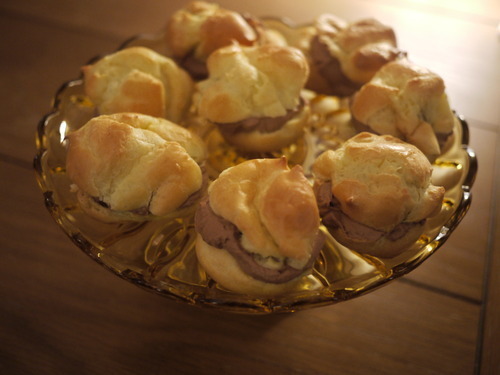
Thank you for your continued support through this extended hiatus. We can be parents, bankers, writers and bloggers simultaneously.
July 20, 2014
Delicious!/Gingerbread Cake
Reading about food is the truest collision of this blog’s motivations. Food memoirs, histories and stories create such a thriving, sensate world. I’ve had the pleasure of reading a few of Ruth Reichl’s memoirs, including Tender at the Bone and Comfort me with Apples. She’s a beautiful writer, and as the head of Gourmet Magazine for years before it folded, she’s clearly passionate about food.

Delicious! is Reichl’s first foray into the world of fiction. The novel tells the story of Billie Breslin, who arrives in New York City to work as an assistant editor at a magazine that’s curiously similar to Gourmet, and it too folds just as she begins to get comfortable there. While she’s the lone employee who’s hired to see some of the transition of the takeover through, she stumbles across a hidden cache of letters between a young woman named Lulu and the indomitable James Beard. It’s clear to the reader that Billie has a lot of emotional baggage that she is trying to leave at the NYC border, but that’s proving easier said than done.
During her interview, she impresses the editor-in-chief of Delicious! with her gingerbread cake, a recipe that has been in the family for generations, and which becomes immediately clear is part and parcel of the baggage that she’s trying to shed. The EIC is so taken with this cake, that he hires her on the spot. For the rest of the book, while Reichl weaves a charming, romantic story that’s perfect for these lazy summer hours, I found myself wanting, needing, having to have that cake.
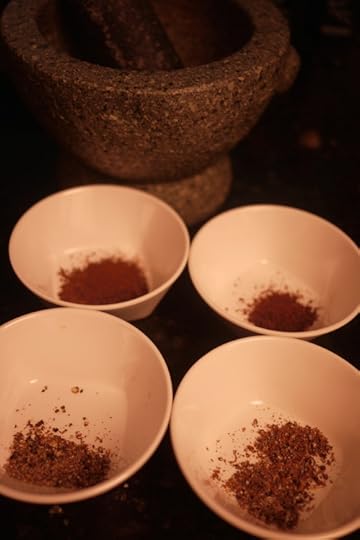
Thank goodness Reichl provides the recipe on the last page.
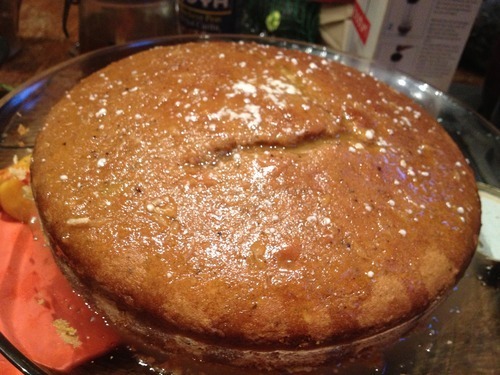
Inspired by Delicious! by Ruth Reichl
Ingredients:
Whole black peppercorns
Whole cloves
Whole cardamom
1 cinnamon stick
2 cups flour
1 teaspoon baking powder
1 teaspoon baking soda
½ teaspoon salt
3 large eggs
1 large egg yolk
1 cup sour cream
1 ½ sticks unsalted butter (room temp)
1 cup sugar
3 inches (2 large pieces) fresh ginger root (tightly packed, when finely grated)
zest from 2-3 oranges (1 ½ teaspoons finely grated)
Directions:
Preheat oven to 350 F. Butter and flour a 6-cup Bundt pan. (Note: we didn’t have a Bundt pan and just used our springform, which turned out fine).
Grind your peppercorns, cloves, cardamom and measure out ¼ teaspoon of each. (Note: we used double the amount and it tasted amazing)
Grind your cinnamon stick and measure out 1 teaspoon. (Note: we used the entire ground stick and it tasted amazing)
Whisk the flour with the baking powder, baking soda, and salt in a small bowl.
In another small bowl, whisk the eggs and egg yolk into the sour cream. Set aside.
Cream the butter and sugar in a stand mixer until the mixture is light, fluffy and almost white. This should take about 3 minutes.
Grate the ginger root – this is a lot of ginger – and the orange zest. Add them to the butter/sugar mixture.
Beat the flour mixture and the egg mixture, alternating between the two, into the butter, until each addition is incorporated. The batter should be as luxurious as mousse.
Spoon batter into the prepared pan and bake for about 40 minutes, until cake is golden and a wooden skewer comes out clean.
Remove to a rack and cool in the pan for 10 minutes.
SOAK
½ cup bourbon
1 ½ tablespoons sugar
While the cake cools in its pan, simmer the bourbon and the sugar in a small pot for about 4 minutes. It should reduce to about 1/3 cup.
While the cake is still in the pan, brush half the bourbon mixture onto its exposed surface (the bottom of the cake) with a pastry brush. Let the syrup soak in for a few minutes, then turn the cake out onto a rack.
Gently brush the remaining mixture all over the cake.
GLAZE
¾ cup powdered sugar, sifted or put through a strainer
5 teaspoons orange juice
Once the cake is cooled, mix the sugar with the orange juice and either drizzle the glaze randomly over the cake or put it into a squeeze bottle and do a controlled drizzle.
April 1, 2014
A Marker to Measure Drift/Lamb Gyros
I’ve found myself reading a lot of books about war-torn Africa lately. I’m not sure if it’s a literary trend, or just the genres I’ve been gravitating towards. But at face value, Alexander Maksik’s A Marker to Measure Drift isn’t about Africa at all.
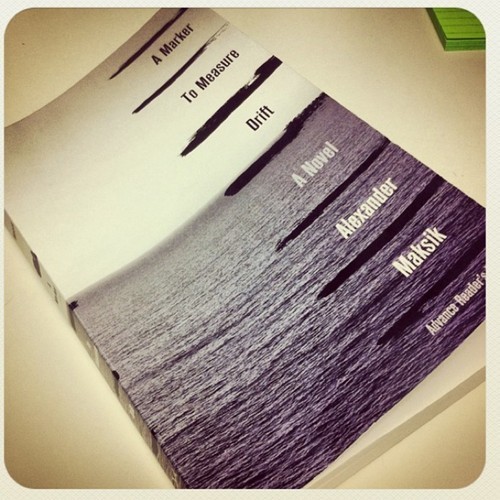
It follows a young woman, appropriately adrift and attempting to stay afloat as she navigates the paradisiacal island of Santorini in the wake of a horribly war torn departure from her native Liberia. While you’re not sure what happened to Jacqueline until the very end of the story, suffice to say that she is certainly suffering from some form of PSTD, you are heartbroken alongside her as she wanders the white sands, as she seeks shelter in broken rock coves, forages nourishment from beach trash cans and attempts to create as much distance from her past as she can.
Jacqueline’s story is one of survival. While the reader isn’t quite what it is that she has survived, the didactic voice of her mother echoes in her head, reminding her that she is alive, and she is to remain so at all costs. Maksik writes in broken sentences, conveying the disparate and stilted manner in which Jacqueline lives each day. When she finally comes into some money from giving cheap massages on the beach, she treats herself to gyros from a gyro stand on the boardwalk.
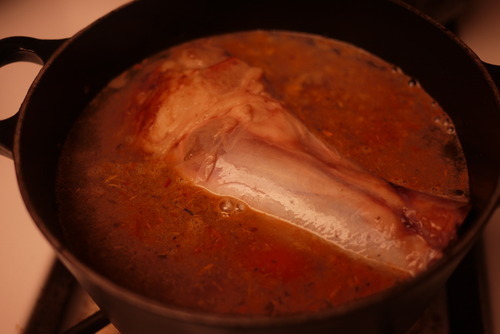
After reading pages of her salivating over the aromas of the charcoal plumes emanating from the revolving spit, I had to have a gyro. Jacqueline alternates between lamb and pork gyros, allowing herself to feel the luxury of choice over a meal that manages to fill her up with very little cash.
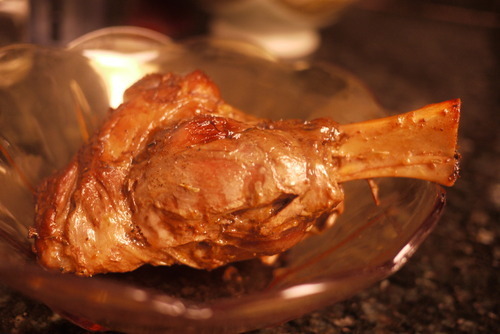
While we don’t have a roasting spit or the luxury of open flames in our NYC home, Rohit improvised by braising a lamb shank for 2 hours in a dry white wine and tomato stock spiced with juniper berries, allspice, oregano and plenty of garlic until the meat became tender enough to fall off the bone. While gyro meat is traditionally served dry, with only hot sauce or tzatziki as accompaniment, the braising sauce was too good to forgo. So Rohit strained, pureed and returned it to the stove to reduce, whereupon he added it to the pulled lamb meat, resulting in a gyro in which I was more than happy to indulge, leaving the memories of a ravaged Liberia behind.
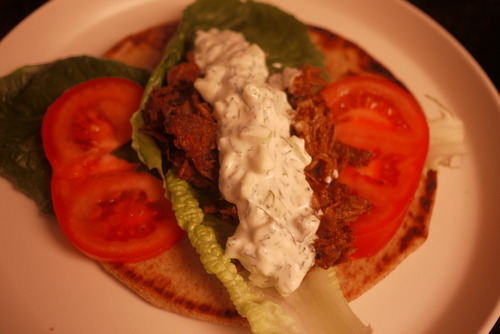
March 5, 2014
Oscars Dinner 2014
Phew. We needed a few days to recover from our Oscar Party. There was a frenzy of cooking over the weekend, and before that, a frenzy of movie watching. This year, there were a great number of movies that were based on true stories, with some really difficult film to food conversions, but hopefully we made it work. Let us know what you think. Here are the nominees:
Dallas Buyers Club: Based on a true story, Ron Woodroof (Matthew McConaughey) plays the lead role of a macho, highly sexualized cowboy, who learns that his philandering and drug shooting ways have resulted in his contracting HIV. In these early days, when little was known about cures or how to manage symptoms, AZT was one of the first drugs on the market. The movie follows Ron’s journey as he seeks the healthy cocktails of drugs that can help him and his fellow AIDS sufferers as they try their hardest to survive one of the largest scale health catastrophes in history. We served the AZT Cocktail: Absolut Vodka, Zico Coconut Water and a Twist of orange peel (not pictured)
Nebraska: Woody Grant is convinced that the mega sweepstakes notification he has received in the mail means that he is the rightful recipient of one million dollars, and he’ll stop at nothing to get to Lincoln, Nebraska to claim his prize. When he returns to his hometown with his son in tow, his past greets him and it isn’t necessarily pleased to see him. What’s worse: Woody is an alcoholic who doesn’t believe that beer is alcohol, and drinks far more than a man his age should. We served Craft Beer (not pictured)
Gravity: While there wasn’t a whole lot of plot to this movie, the visual effects were truly stunning. A space mission goes awry and three astronauts are lost in space. The majority of the movie takes place in space and as a viewer, you feel truly weightless watching the actors (Sandra Bullock and George Clooney) float around in the abyss. To give our guests that similar sensation, we made Lighter-than-Air Cheese Gougeres.
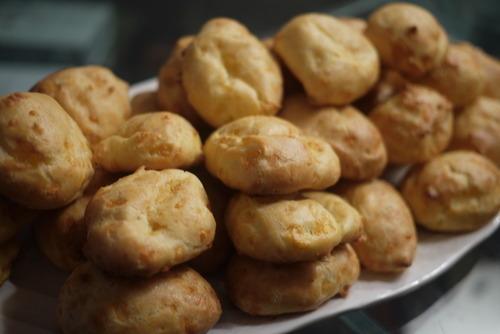
The Wolf of Wall Street: Martin Scorcese’s blockbuster tells the true story of Jordan Belfort who stole, swindled, conned, snorted and screwed his way to riches. The movie is replete with cocaine, hookers, nudity, yachts and sex. While all of it is rather crude, many of the stockbrokers involved with the actual scam have avowed that the retelling of this tale is actually pretty truthful. As a nod to Belfort’s decadent nature, we served Mini Brioches with Crab Salad, Fried Onion, Dill and Salmon Roe.
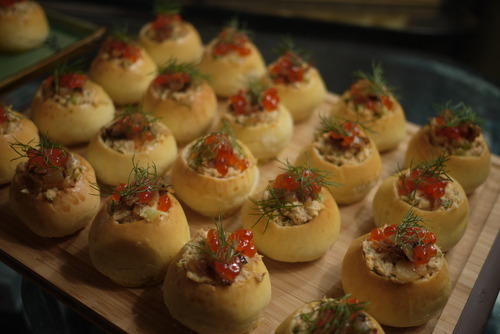
And as an homage to Wall Street’s love affair with steakhouses, we served steakhouse sides: Creamed Spinach,
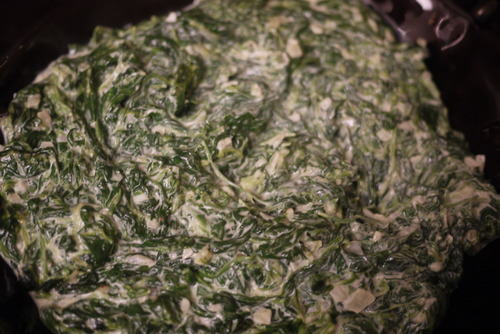
Roasted Asparagus with Crispy Garlic,
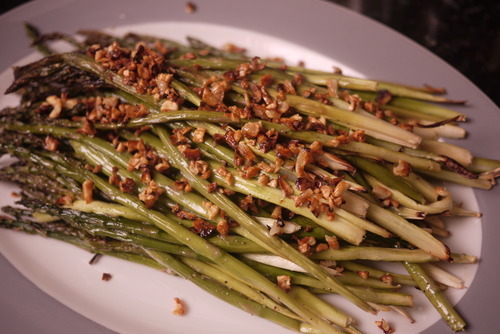
and Roasted Potatoes Tossed in Truffle Oil
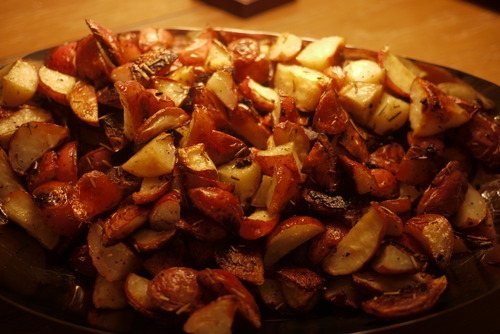
12 Years a Slave: One of the most brutally honest movies we watched, it tells the true story of Solomon Northrup, an emancipated black man living in the North who is tricked and sold into slavery down South unbeknownst to his family. As the title suggests, for twelve years, he lives in abject slavery. As he eats blackberries one night, he notices the juice trail they make across his tin plate and gets the idea to create some ink and write a letter to his family so that they might rescue him. We served Blackberry Cornbread.
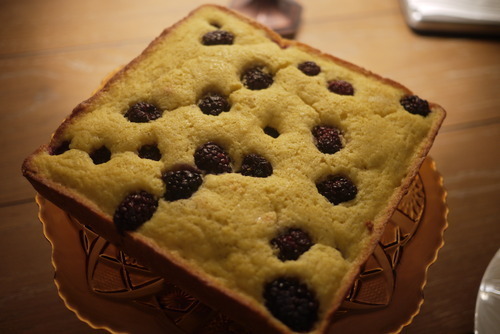
Her: One of my favorite movies from this year, Her is a charming – albeit rather bizarre – story of a man who falls in love with his operating system, similar to the Siri that we iPhone users all know and love. Theodore (Joaquin Phoenix) realizes that Samantha (voiced by Scarlett Johansson) is more of a woman than he’ll ever meet in real life, and he embarks on a relationship with her. On one of their “dates” at a carnival, Samantha forces him to close his eyes and steers him towards a pizza truck where he orders a slice without knowing what he’s just bought. We made a Pesto Pizza with Fresh Mozzarella.
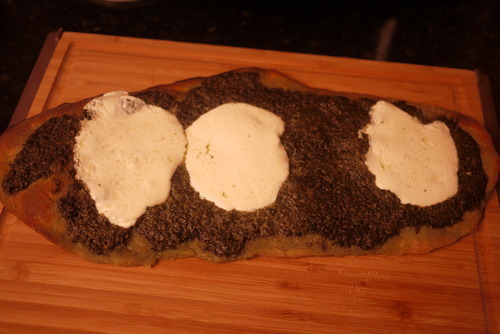
Captain Phillips: A dramatic, edge-of-your seat true story about a container ship trying to make a delivery that is hijacked by a handful of Somali pirates. Masterfully played by leads Tom Hanks and Barkhad Abdi, at times, you’re never sure whose side you’re on. As one can imagine, food doesn’t play much of a role here, but the pirates are constantly chewing khat, a hallucinogenic plant that staves their hunger. We made our own: Fried Parsley “Khat” with Cajun Seasoning, though this was so delicious that it most certainly did not stave our hunger.
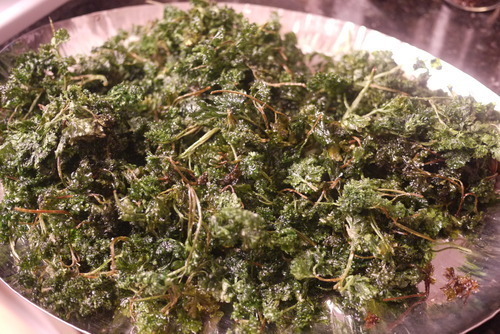
American Hustle: What happens when the FBI forces a con man to work for them? Take some really big 70s hair, lots of plunging necklines, some serious Longuyland accents, and the Italian mafia and you’ve got the ingredients for American Hustle. We were inspired by the Italian connection, and mostly by Richie DiMaso’s (Bradley Cooper) hair to make: Jheri Curl Fusilli Bolognese.
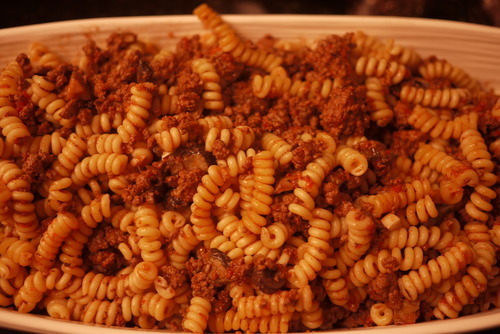
Philomena: The true story of an Irish woman who lives in a convent and gives birth to a child out of wedlock. Years later, Philomena wonders what became of the son that was taken away from her and adopted by strangers. The Guinness harp plays a major role in uncovering the truth about her son, so we made a Chocolate Guinness Cake.
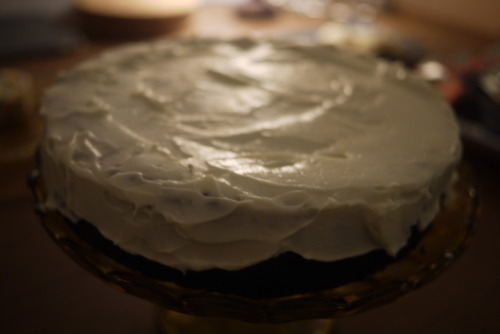
One of our guests surprised us with another dessert for Gravity: Astronaut ice cream.
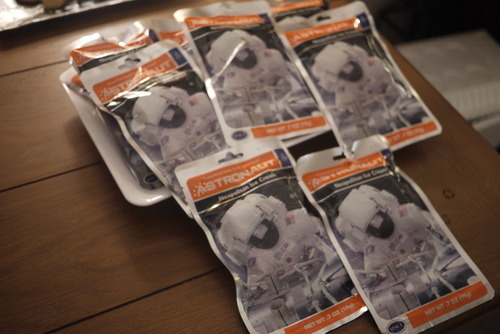
Ultimately, at the end of a long, but very festive night, the winner was 12 Years A Slave. Which dish would you award the winner of the night?
February 19, 2014
The Rosie Project/A Red & Pink Valentine's Day Dinner
This is a love story. Of that, there’s no doubt. And you sort of see what’s going to happen between boy and girl from the outset. But the charm of The Rosie Project by Graeme Simsion is truly the journey and not the destination.

Don Tillman works in a genetics lab and there is order to every aspect of his life. He wears the same clothes on every single Monday, he cooks the same meal on every single Tuesday, he doesn’t waste a single minute of his time that could be spent doing something else more valuable. He bikes to work so that he doesn’t waste time commuting and therefore is at least exercising, and he can’t stand small talk. That is, to be more precise, he doesn’t quite know how to make it.
Don is rather socially challenged; in fact, he rather sadly lectures about Asperger’s without recognizing that he displays all the symptoms. But of course, that doesn’t mean that he shouldn’t spend the rest of his life alone. Like every other venture in his life, he takes up The Wife Project, a highly scientific questionnaire designed to help him find the appropriate wife – a non-drinking, non-smoking, paragon of virtue in his mind (suffice to say that this Barbie doll does not exist). Enter Rosie, a brash, nutty, flurry of a woman who challenges everything Don believes makes up the ideal woman. But she’s not after him for romance; she wants to use his connections in the genetics lab to locate her biological father.
Yes, they’ll end up together. The cover is bright red with hearts on it, so I’m not the spoiler alert. But how they get there is truly magical. After all, isn’t the journey what makes the greatest love stories worth swooning over?
We coincided the meal for this book with Valentine’s Day, a holiday that neither Rohit nor I are particularly keen on. So, we invited a couple that we love over to enjoy a red and pink feast.
We started with appetizers: a beautiful smoked salmon carpaccio with pomegranate purée, diced red apple, blood orange zest and dill.
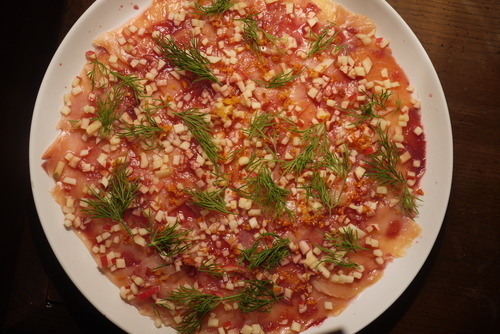
And a roasted cherry tomato crostini with sun dried tomato, piquante pepper, habanero and roasted garlic for some spice and sweetness.
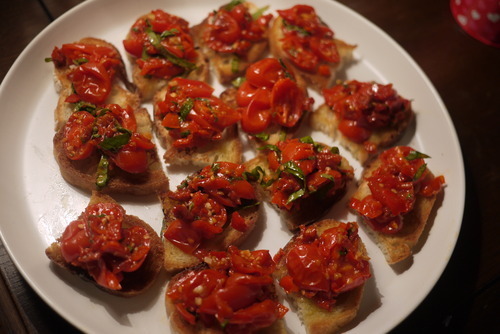
We continued on to a grilled hangar steak taco with harissa marinade, red beet and red onion relish and sliced radish.
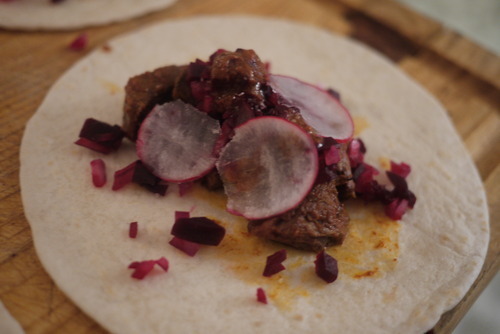
And finally, for the sit down portion of the meal, poached red beet salad with red wine vinegar, crispy kale leaf, macadamia nut…
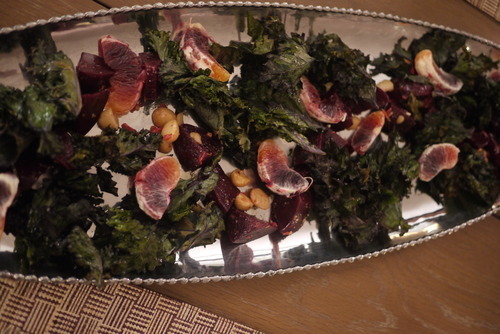
…and a roasted monkfish tail with Kashmiri chili-infused tomato curry, crispy ginger, and curry leaf.
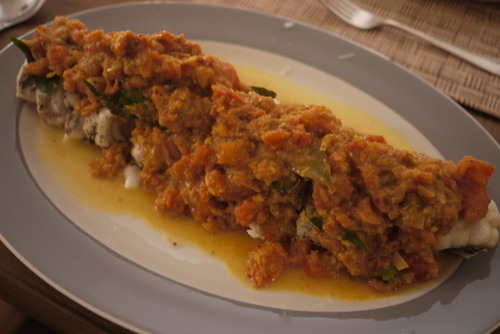
I made (non red) chocolate mousse as a more typical Valentine’s Day dessert. It wasn’t Don Tillman’s version of a Valentine’s Day (truly, what is?) but the holiday is all about love, and with Rohit and me and Sylvester and Shabnam (who got married the same year we did, in fact!), there was a whole lot of love at the end of this culinary journey.
January 14, 2014
The Family Fang/Avant Garde Black Pasta
The Family Fang by Kevin Wilson is one of the lighter books I read this year; it’s funny, irreverent and deliciously dark. The Fang Family is comprised of “parents” Caleb and Camille. The pair are performance artists of the most insensitive kind – they bring their children Annie and Buster into the fold, coercing them to be part of their “acts” before they are aware that they are accomplices. They stage situations in public places- malls, parks, preying upon human nature and behavior in order to learn what people will do when placed in precarious situations.
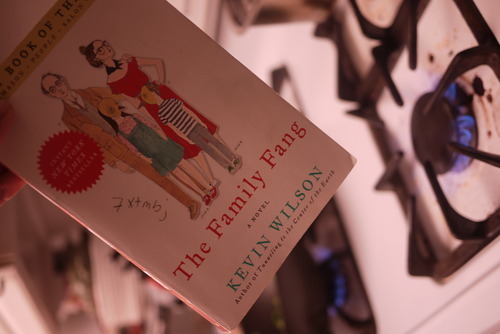
At first, the acts were amusing, and truly inspired. They took a great deal of thought to set up and act out, drawing upon the darkest nether regions of the most twisted human mind, and charting out from start to finish what could – and could not – happen. But after some time, I began to feel for the Fang children; they were abetting what could be considered crimes, without understanding the impact these performances had on their lives.
In their adult years, Annie and Buster begin to realize the influence their parents have had on them, from their jobs to their friends to their apparent unraveling. And when they come home to stay with their parents out of necessity, they realize the dire consequence their parents actions have had on their lives.
To echo this unsettling feeling I experienced while reading The Family Fang, Rohit created his take on an aberrant avant garde piece, one that made me squirm if I thought too hard about it. When it had first opened years ago, I had visited Gabrielle Hamilton’s Prune restaurant on the Lower East Side of Manhattan. At the time, I wasn’t eating pork, which was the mainstay of the brunch menu. So I got what I thought was the safest dish at the time: The Chicken and Egg. When you think about it, it’s sort of a messed up dish: serving a coddled egg along with the poached chicken that it might have been.
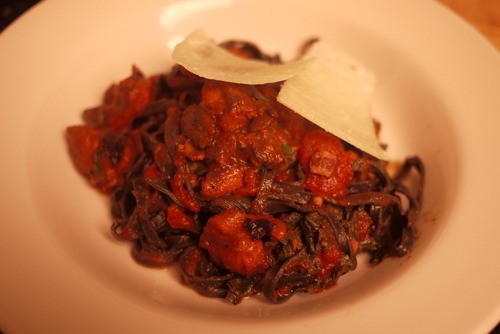
Rohit’s Black Pasta with Octopus reminded me of the way I felt when I ate that dish. He grilled rounds of octopus tentacles and simmered them in a thick tomato sauce along with capers, garlic and chunks of white onion. This was tossed with pasta using octopus ink, the very stuff that octopuses release when they are threatened or being hunted. He sprinkled some chopped parsley over the dish and tilted slivers of parmesan cheese over the bowl. I felt as though I were eating a work of art; one that made me take pause, but also one that made me reach for another helping
November 26, 2013
Salvage the Bones & Wave/A New OrlIndia Feast
Some of the best parts of reading books from different cultures are when a lot of those same emotions, themes and sentiments begin to intertwine with those of other books of other cultures. It narrows the world for me. It reminds me that we’re all a lot alike, you and me, whether we’re from New York City or Tehran. At the end of the day, whatever our politics, our religion, our cultures, we have the same beliefs, the same feelings and very often, the same coping mechanisms. That’s why this is the first blog post mash-up, combining the influences of two different books with similar themes and emotions. In it, friends from New Orleans came together with Rohit and myself to combine two cultures’ cuisines into a New Orl-India feast.
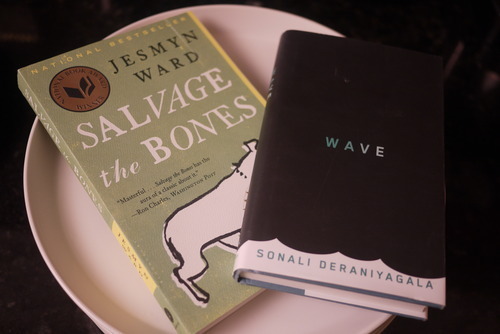
Salvage the Bones by Jessmyn Ward, is a novel of searing depiction of life in the deep South of the lead up and experience of one of the worst natural disasters to hit American soil: Hurricane Katrina. It tells the story of four youngsters who are badly in need of their ever-absent and barhopping father. Esch is fourteen, poor, pregnant, and badly in need of parental advice, and if things couldn’t get any worse, poised on the verge of one of the worst storms to hit their household. The poetry of the narrative lulled me into the raw poignancy of the importance of survival.
Wave is a firsthand account by Sonali Deraniyagala, who lost her entire family in an instant when the 2004 tsunami ripped through the southern coast of Sri Lanka. While the story could have been solely an elegy to grief, I loved it because it celebrates the lives of the people she lost, giving her closure to say goodbye to them in the most public way. Deraniyagala too, had to survive, even though the tsunami had spared her, once she realized that her life was filled with broken pieces.
While our evening was filled with laughter, creativity and lot of spirit (the Saints were playing that night!), it is in times of desperation and solitude that we often turn to food when we are wanting, when we need comfort. This evening was also a brilliant melding of minds: those of our friends Michael and Mark, who represent New Orleans and Rohit, who brought the Desi flavor Indian style, not Sri Lankan.

The essential NOLA cocktail is a Sazerac, a intense cocktail made with bourbon, a few dashes of bitters in a glass rinsed with absinthe. When Rohit and I visited a few years ago, we had one at the original bar where they were invented. To riff off this, I made a cardamom simple syrup with an anise infusion and stirred it with some good bourbon and topped it off with a few dashes of Peychaud’s bitters. It went down a lot easier than the original Sazerac.
We started munching on Cajun style samosas, which Michael whipped up: homemade samosa dough stuffed with stewed crayfish, mashed potatoes and peas.
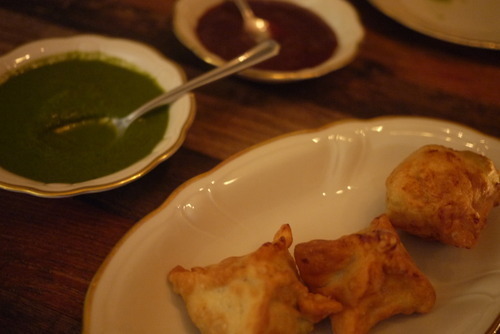
Rohit married the two cultures with his bite size crab cakes made with a fish mousse base and a tomato base that encompassed a lot of Indian spices. He served it with a remoulade, a quintessential NOLA sauce, atop a cucumber round.
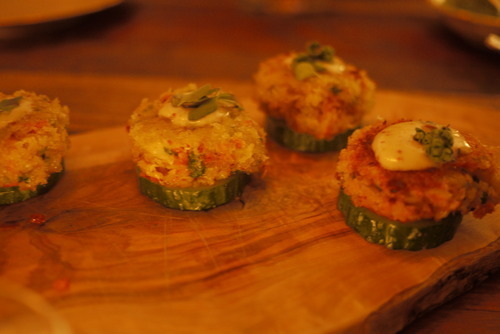
The appetizers continued with what we titled the “Ro-Boy,” a take-off of a po’boy using chapatti bread instead of a baguette-like French bread, shrimp that had been marinated in Creole mustard, radicchio, heirloom tomatoes and mango pickle.
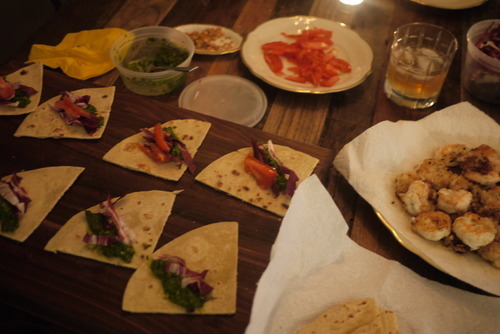
And the food just kept on coming. Mark introduced his Goa-umbo, a hearty stew that he made with chicken, Andouille sausage, along with a smattering of Indian spices, including turmeric, ginger and cumin. In true Desi style, he served this with a healthy portion of Basmati rice.
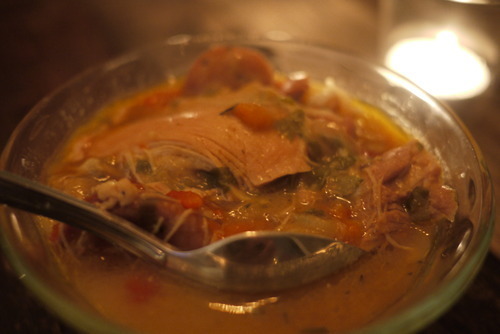
And finally, Michael served us each a beautiful piece of sea bass en papillote. It had been cooked in coconut milk, along with mint, toasted cashew nuts (very Goa-style) and some steamed asparagus.
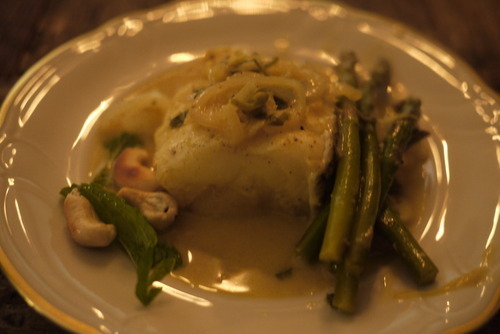
Just when we thought we couldn’t get another bite in edge-wise, the girls brought it home with a Bananas Chili Foster, a typical New Orleans dessert that we spiced up. Shannon cooked the bananas with a chili pepper, and doused it in fire. We served it with a fennel ice cream that I had made beforehand.
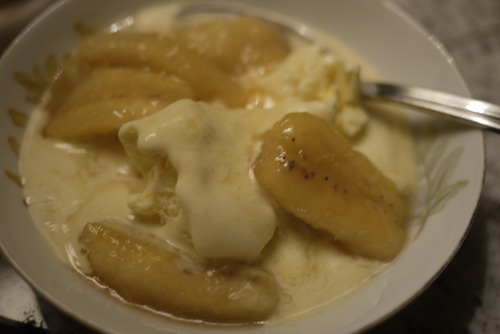
It was gratifying: great friends, excellent food and the mashing of cultures. Oh, and the Saints won. Not bad for an evening of comforts.
November 5, 2013
Angela's Ashes/Pan-fried Bluefish with Sweet Potato Fries and Mushy Peas
Whenever we travel, I love to read books from that area. I load up on native writers, inhaling and immersing myself in that world – the food, the customs, the language, the politics. In Ireland, a country where literature rules the roost, it was no different. I brought a stack of Irish novels along with me, which proved to be completely unnecessary since I ended up buying 18 more books along the way. This time, I insisted that Rohit do the same and I armed him with one of my quintessential Irish reads: Frank McCourt’s Angela’s Ashes.

Angela’s Ashes holds a dear place in my heart. McCourt used to teach English at my alma mater, Stuyvesant High School. Sadly, I missed the opportunity to have him as a teacher just by a few years, but I fell in love with his voice and his work. I haven’t read it since it was first published 17 years ago, but I have fond moments and memories of his story of a poverty-stricken childhood in Limerick.
At times, while Rohit was reading the book, I would peek over his shoulder to catch phrases and anecdotes of what McCourt was surrounded by: the raucous drinking, the threadbare clothing, the freezing home, the fun they had despite having had so little. But there was one memory of the book I had that I haven’t been able to shake since I first read the book. The McCourt children grew up in such dire poverty that at times, their dinner was a few biscuits and a cup of very weak tea.
To add insult to injury, there was a fish and chip shop not far from their home and on nights when their hunger pangs got the better of them, they would stand outside and inhale the smells of fried potatoes and vinegar wafting from the shop. They would position themselves opposite the shop, wait for a patron to finish his fish and chips and once he had tossed the newspaper aside that held the fried goodness, the kids would dive for it and suck the oil and the bits of breaded fish and whatever small pieces of fried potatoes had stuck to it.
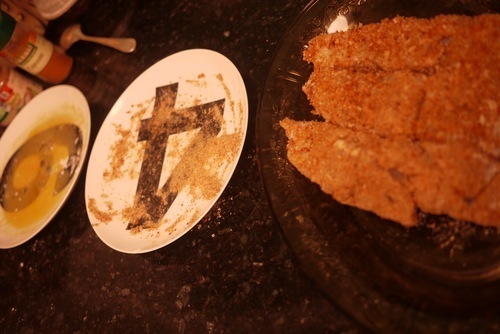
It was such a melancholy but poignant memory to me - the hunger these boys felt - that it made me crave fish and chips. And of course, we had them our way – slightly healthier, as Rohit chose to pan fry our fish and make sweet potato fries. He added seven spices to the flour batter, including mace, celery salt, cayenne pepper and cumin.
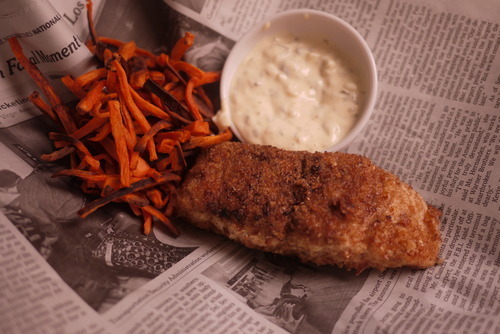
And of course, we had them with the most Irish of accompaniments – mushy peas and homemade tartar sauce.
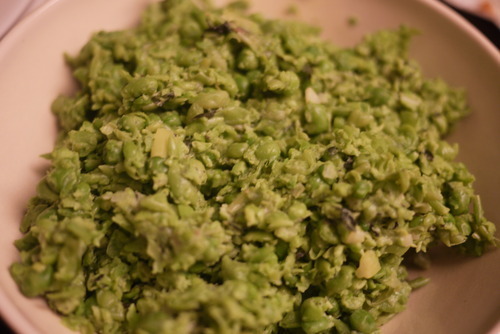
Isn’t that the best way to raise a glass of Guinness to dear departed Frank McCourt and pay homage to the poetry in the memoirs that he left behind?
‘Tis.
October 28, 2013
The Lowland/Salmon in Bengali Mustard Sauce
If you’re like me, you have a set of favorite writers whose books you anticipate in the time it takes to write them. Jhumpa Lahiri is one of them.
Lahiri’s new book, The Lowland, is the story of two brothers who are born and raised in Calcutta, in a relatively middle-income household. While they have similar trajectories throughout their childhood, as they mature into college age, one heads into the field of environmental science, pursuing a Masters and then ultimately a PhD in Rhode Island, while the other dances dangerously close to the Naxalite movement, a violent uprising with Communist ties that sought to redistribute land to the landless. While one brother’s loneliness looms palpably over his studies, the other’s fierce tenacity and obduracy to fight for what he believes in brings trauma to his family and the dutiful brother is called upon to pick up the pieces of his broken family.
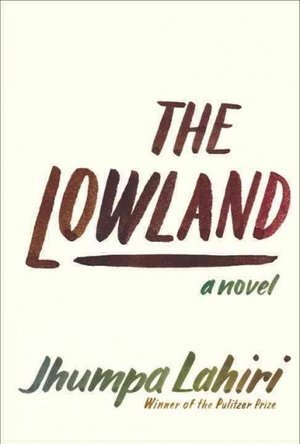
While most of the story takes place in New England, Bengal and Bengali culture are omnipresent. From the food he cooks to the manner in which he raises his daughter, this is a quintessentially Bengali story, right down to the book’s politics. While mustard is used all across India, mustard paste is unique to Bengal. This time, I wanted to try my hand at making one, so I let Rohit off for the night from culinary duties.
I used our molcajete, a Mexican grinding stone, to pulverize ground turmeric, cayenne pepper and brown and yellow mustard seeds to a powder, mixing in some water to create a paste. Then I brushed the paste onto a large slab of salmon, a meaty fish that would stand up to the pungency of the mustard paste. I dropped some cumin and fennel seeds and dried red chilies into sizzling oil and set the salmon filet on top.
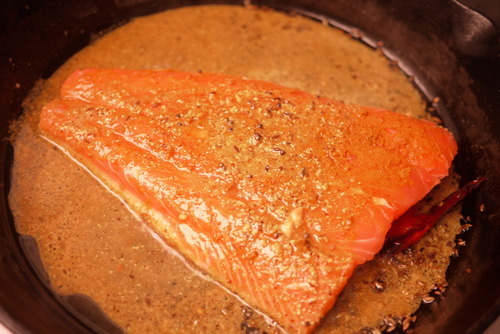
Never one to waste salmon skin when it’s been crisped to perfection – especially in a homemade mustard paste – I served that alongside the piece of fish with fragrant jasmine rice and some not particularly Bengali broccoli for greenery. Rohit, the resident Bengali in our home, proclaimed my mustard fish to be on par with kasundi, the Bengali mustard of his childhoods spent in his grandparents’ home in Calcutta.

While I didn’t fall head over heels for this book like I had in the past for say, Unaccustomed Earth (which I finished in bed, wracked with sobs), I did have a realization: my writing style is similar to Lahiri’s. I don’t know what that means about me as a writer – does that mean that I wouldn’t actually like my own work if I were reading it as a naïve reader? I found that we narrated similarly, with dialogue that seemed interchangeable. I wonder if she would agree.
October 19, 2013
Heartburn/Rachel’s Comforts: Vinaigrette, Linguine alla Cesca and Peach Pie
As a writer, there are some talismans I have at my writing desk, and a photo of Nora Ephron is one of them. She was a true inspiration to me. She wrote novels and screenplays and did it with such a gusto and love for the written word that she continued writing even when she was bedridden with leukemia. That woman had a fire inside her. She inspires me to write my heart out and to do what I love. My friend Kamala feels the same about Nora. So we decided to Nora’s first novel, Heartburn together, make a meal from the recipes in the book and enjoy it while watching the movie.
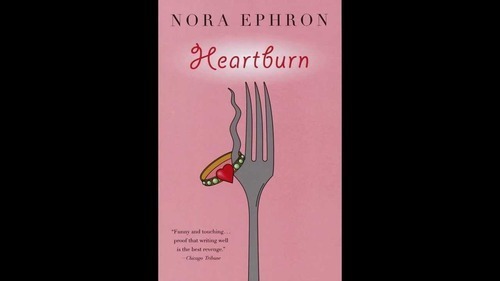
I’ll admit: reading Nora Ephron’s Heartburn for our blog was a bit easy. After all, the book is about a cookbook writer, Rachel, who learns that her husband is cheating on her while she is pregnant with their second child. Personally, I’m with Rachel when it comes to this scenario (spoiler alert): cook great food, enjoy it, and then dump his butt.
But the reason I loved this book was because it exemplified this blog to a t: she cooks what she is feeling. She cooks how she is feeling. While the therapy-old/eating disorder mantra is, “Don’t eat your feelings,” as a cuckolded, pregnant cookbook writer, Rachel realizes that’s the only way to cope.
“In the end, I always want mashed potatoes. Mashed potatoes. Nothing like mashed potatoes when you’re feeling blue. Nothing like getting into bed with a bowl of hot mashed potatoes already loaded with butter, and methodically adding a thin cold slice of butter to every forkful. The problem with mashed potatoes, though, is that they require as much work as crisp potatoes, and when you’re feeling blue the last thing you feel like is hard work. Of course, you can always get someone to make the mashed potatoes for you, but let’s face it: the reason you’re feeling blue is that there isn’t anyone to make them for you. As a result, most people don’t have nearly enough mashed potatoes in their lives, and when they do, it’s almost always at the wrong time.”
Rachel supplies the recipes for her comfort food dishes, including one of her secret weapon recipes for her famous vinaigrette. She believes that the vinaigrette is so good that Mark wouldn’t want to risk their relationship over losing that vinaigrette. So Kamala and I had to make that. We paired it with a simple arugula and endive green salad.
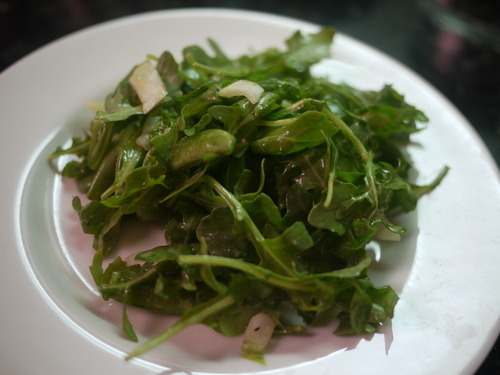
We made Linguine alla cesca, a dish that Rachel managed to weasel out of a chef on a trip to Italy with her friends.
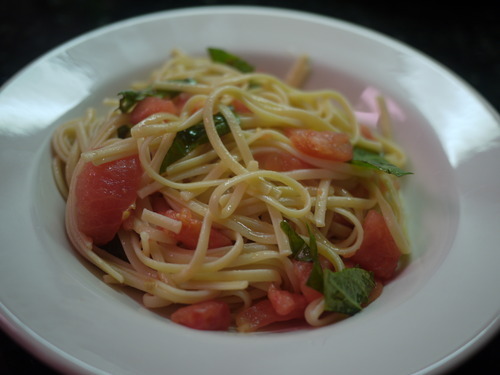
And while we loved the idea of comfort mashed potatoes, neither of us were particularly keen on the tubers, so we made comfort sour cream peach pie instead.
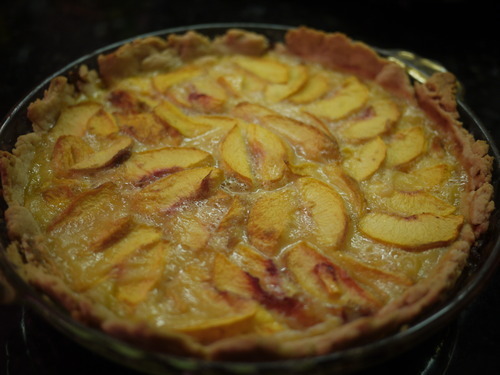
While I can’t imagine the loneliness and abandon that Rachel must have felt, I can imagine how much solace she received from her cooking and her ability to continue doing what she loved in her time of chaos and anger.



